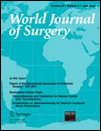Parathyroid Four-Dimensional Computed Tomography: Evaluation of Radiation Dose Exposure During Preoperative Localization of Parathyroid Tumors in Primary Hyperparathyroidism
Abstract
Background
Parathyroid four-dimensional computed tomography (4DCT) provides greater sensitivity than sestamibi with single photon emission CT (SPECT, or SeS) for preoperative localization of parathyroid tumors in patients with primary hyperparathyroidism (PHPT). The radiation dose imparted to the patient during preoperative parathyroid imaging, however, has not been analyzed.
Methods
Patients with biochemically unequivocal PHPT referred for minimally invasive parathyroidectomy underwent 4DCT or SeS. 4DCT was performed using a 64 detector row CT scanner, and SeS used a standardized protocol of 20 mCi of technetium-99m followed by planar and SPECT imaging. The CT radiation dose was estimated using the Imaging Performance Assessment of CT Scanners (ImPACT) calculator, and the SeS dose was estimated using the US Nuclear Regulatory Commission Regulation (NUREG) method.
Results
The calculated effective doses of 4DCT and SeS were 10.4 and 7.8 mSv, respectively, in contrast to an estimated annual background radiation exposure of approximately 3 mSv. The dose to the thyroid with 4DCT, however, was about 57 times higher (92.0 vs. 1.6 mGy) than that with SeS. Based on age- and sex-dependent risk factors, the calculated risk of 4DCT-related thyroid cancer developing in a 20 year old woman was 1,040/million (i.e., about 0.1%).
Conclusions
4DCT, a superior preoperative imaging modality for locating parathyroid tumors, imparts a significantly higher thyroid radiation dose than SeS. Given the enhanced risk of thyroid cancer in individuals with radiation exposure at a young age, 4DCT should be used judiciously in young PHPT patients.




